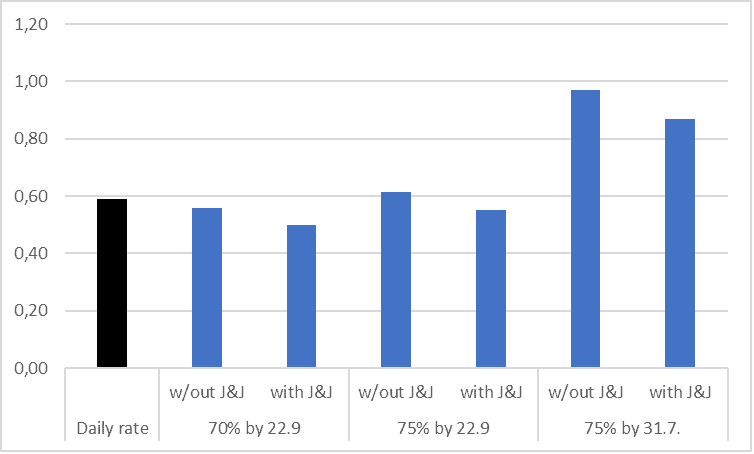Two months ago, dissatisfaction with vaccine roll-out in the European Union was widespread. Just over 7 per cent of the population had received a shot and the daily vaccination rate was under 0.2 per cent. The EU announced a goal: 70 per cent of adults were to be vaccinated by September 22nd. That entailed a daily rate of more than 0.5 per cent of the population—a more than 2.7 times boost.
It is time to revisit that analysis. The pace of vaccination has increased substantially—although with country differences—as supply constraints have eased. The EU should adopt a more ambitious vaccination target, of 75 per cent of adults by the end of August—possibly sooner.
The state of play is presented in Figure 1 (the data are from Our World in Data, as of May 3rd). The columns show shots administered per 100 population (left axis) and the latest seven-day average for daily vaccinations (right axis). Most countries are bunched close to the EU average, which stands at just under 34 per cent and a daily rate of just under 0.6 per cent, with a small number of outliers.
Figure 1: total and recent daily vaccinations by member state (% population)

From this starting point we have calculated the vaccination rates needed to achieve three different policy goals. The current EU rate—which applies to the total population—of 0.59 per cent per day is faster than that required to achieve the target of 70 per cent of adults by September 22nd: even assuming two doses per person, only a 0.56 per cent daily rate is needed. Allowing for the fact that the Johnson & Johnson vaccine needs only one shot, that falls to 0.5 per cent. (Based on available German delivery data, we conservatively assume that 15 per cent of shots given from now on are J&J.)
At the current vaccination rate, the 70 per cent target would already be reached towards the end of August. Clearly the EU could and should strive for more ambition.
Ambitious goal
Figure 2 shows that without any further acceleration the EU could achieve more than 75 per cent vaccination coverage by September 22nd (provided 15 per cent of shots lead to full vaccination). It also shows what would need to happen to achieve an ambitious goal of 75 per cent of the adult population already by the end of July—within around 90 days of this data collection. On a realistic assumption about the role of J&J the required daily vaccination rate is 0.87 per cent.
Figure 2: current and target daily EU vaccination rates

Turning to individual member states, Figure 3 shows the ‘acceleration factor’ by which countries need to increase (or could decrease) their recent vaccination rate to achieve each target. Most are already on track to reach the 70 per cent target. Some—mostly in eastern Europe but also Greece and the Netherlands—still need a not-insignificant boost to vaccination rates, by 30-50 per cent. The outlier Bulgaria needs to more than treble its rate.
What is remarkable is the small additional effort required overall to achieve 75 per cent coverage of those over 18 by the September equinox.
A considerably more difficult task is to bring forward the achievement of the 75 per cent goal to the end of July. Apart from the outliers Hungary and Malta, this latter requires extra effort on the part of all countries.
Given the short time involved—less than 90 days—a doubling of rates from current levels, as would be needed in ten countries, looks a tall order. Equally, apart from the two best-in-class outliers, for a further 13 countries an acceleration of a maximum of around 60 per cent—and for Spain and Germany only a touch over 10 per cent—would bring this ambitious target within reach. This group includes the five largest countries—Germany, France, Italy, Spain and Poland—which alone account for two-thirds of the EU population.
Figure 3: acceleration factors to achieve vaccination targets

Europe should take a ‘Yes we can!’ approach to the vaccination campaign, building on recent progress. The EU policy target should immediately be raised from 70 to 75 per cent of adults and could at the same time feasibly be brought forward—if not to the end of July at least to the end of August.
What is the importance of the additional five percentage points? Remember we are discussing the adult population. The meaning of ‘herd immunity’ is imprecise—strictly speaking, it applies when, in the absence of any restrictive measures at all, the reproduction rate (R) falls virtually to zero. Experts are unsure of the exact figure, but this would require a very high vaccination level. Even allowing for the continuation of some of the less encumbering restrictions, a vaccination incidence of 70 per cent of adults, or less than 60 per cent of the total population, is substantially below what is required for a pragmatically defined herd immunity and to limit the risk from new variants.
Total injections corresponding to the full vaccination of 75 per cent of adults should be seen as a minimum. The European Medicines Agency is considering an application to make the BioNTech/Pfizer vaccine available also for youngsters down to the age of 12. This would mark an important further enhancement of protection.
More than adequate
How realistic are more ambitious targets? The supply of vaccines has improved dramatically. There is, of course, uncertainty regarding future deliveries. But taking German data as a point of reference—because of the common procurement system these can be extrapolated—supply should be more than adequate.
Deliveries to German vaccine centres and doctors’ practices are foreseen to rise from around four million doses in the last week of April (the basis for the recent vaccination trend in the above calculations) to possibly five and a half million a week during May and to a minimum of six million in June (the latter figure makes no allowance for AZ via doctors’ practices and no J&J at all). Only somewhat older forecasts are available for the third quarter but they exceed the June estimates. And from July the CureVac vaccine, should it receive EMA approval in time, will make an initially small additional contribution.
Excluding the additional possible supplies would permit 1 per cent of the German population to be vaccinated every day. Extrapolating to EU level, even this absolute minimum volume of expected deliveries would be above the 0.8-0.9 per cent daily rate that would suffice for the vast majority of EU countries to achieve the most ambitious target discussed here.
When supply is available, the capacity to deliver vaccine to people’s arms can quickly be created and sustained. Israel, Hungary, Malta and the United States have maintained daily vaccination rates close to 1 per cent for extended periods. Germany, Spain and some other EU countries have seen rapid hikes in their capacity to administer doses, expanding vaccination centres and mobilising doctors’ surgeries as supply constraints have lifted.
Convinced and cajoled
At least initially things get easier as prioritisation becomes less important and the special needs of the sick and elderly no longer play such a role. As vaccination rates rise, however, harder-to-reach groups will need to be targeted, convinced and maybe even cajoled. In countries where the campaign has been most successful, such as the US, there are already signs that it is tailing off before anything like herd immunity is achieved. EU countries need promptly to address vaccine hesitancy and scepticism and find ways to reach target groups.
Speed is important. Vaccination saves lives and permits battered economies to resume operation, easing the burden on public finances, so every day counts. Still, what is ultimately important is achieving a level of vaccination—without regional coverage gaps, risking flare-ups—that keeps the virus at bay.
A more demanding target, even if it cannot be achieved by all countries, would help Europe raise its common ambition. But a target alone is, of course, not enough: EU countries that have lagged behind should get additional support—even if poor national choices within the common procurement system were largely responsible.
Last but not least, Europe has been the biggest contributor to the global vaccination effort, specifically the Covax programme. But much more needs to be done, through generous licensing and joint-production agreements, to increase production in, and supplies to, less developed countries.


